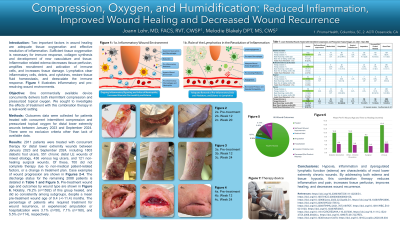Clinical Research
(CR-007) Compression, Oxygen, and Humidification – Reduced Inflammation, Improved Wound Healing and Decreased Wound Recurrence
Friday, May 2, 2025
7:45 PM - 8:45 PM East Coast USA Time

Introduction: Two important factors in wound healing are adequate tissue oxygenation and effective resolution of inflammation. Sufficient tissue oxygenation is necessary for immune response, collagen synthesis and development of new vasculature and tissue. Inflammation related edema decreases tissue perfusion, amplifies recruitment and activation of immune cells, and increases tissue damage. Lymphatics clear inflammatory cells, debris, and cytokines, restore tissue fluid homeostasis, and deescalate the immune response.
One commercially available device concurrently delivers both intermittent compression and pressurized topical oxygen. We sought to investigate the effects of treatment with this combination therapy in a real-world setting.
Methods: Outcomes data were collected for patients treated with concurrent intermittent compression and pressurized topical oxygen for distal lower extremity wounds between January 2023 and September 2024. There were no exclusion criteria other than lack of available data.
Results: 2911 patients were treated with concurrent therapy for distal lower extremity wounds between January 2023 and September 2024, including 1803 diabetic foot ulcers, 551 chronic distal LE wounds of mixed etiology, 436 venous leg ulcers, and 121 non-healing surgical wounds. Of these, 700 did not complete therapy due to non-medical patient-related factors, or a change in treatment plan. The discharge status for the remaining 2088 patients is detailed in Table 1. Notably, 76.2% (n=1592) of this group healed, and did so consistently among subgroups, despite a mean pre-treatment wound age of 9.4 (+/-11.4) months. The percentage of patients who required treatment for wound recurrence was 3.1% (n=50).
Discussion: Hypoxia, inflammation and dysregulated lymphatic function (edema) are characteristic of most lower extremity chronic wounds. By addressing both edema and tissue hypoxia, this combination therapy reduces inflammation and pain, increases tissue perfusion, improves healing, and decreases wound recurrence.
One commercially available device concurrently delivers both intermittent compression and pressurized topical oxygen. We sought to investigate the effects of treatment with this combination therapy in a real-world setting.
Methods: Outcomes data were collected for patients treated with concurrent intermittent compression and pressurized topical oxygen for distal lower extremity wounds between January 2023 and September 2024. There were no exclusion criteria other than lack of available data.
Results: 2911 patients were treated with concurrent therapy for distal lower extremity wounds between January 2023 and September 2024, including 1803 diabetic foot ulcers, 551 chronic distal LE wounds of mixed etiology, 436 venous leg ulcers, and 121 non-healing surgical wounds. Of these, 700 did not complete therapy due to non-medical patient-related factors, or a change in treatment plan. The discharge status for the remaining 2088 patients is detailed in Table 1. Notably, 76.2% (n=1592) of this group healed, and did so consistently among subgroups, despite a mean pre-treatment wound age of 9.4 (+/-11.4) months. The percentage of patients who required treatment for wound recurrence was 3.1% (n=50).
Discussion: Hypoxia, inflammation and dysregulated lymphatic function (edema) are characteristic of most lower extremity chronic wounds. By addressing both edema and tissue hypoxia, this combination therapy reduces inflammation and pain, increases tissue perfusion, improves healing, and decreases wound recurrence.

.jpg)